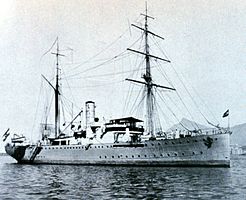Meteor (ship, 1915)
|
||||||||||||||||||||||
|
||||||||||||||||||||||
|
||||||||||||||||||||||
The Meteor was originally called by the Office draft 1913 gunboat for the German Imperial Navy built, but as such unfinished ship in the interwar years as after conversion 1923/24 research vessel of the German Imperial Navy was known. After 1945 it was delivered to the Soviet Navy and served there as an Ekwator until the 1960s, also as a research and survey ship.
Construction and remodeling
The ship was on 26 February 1914 on the Imperial Shipyard in Gdansk under the household name gunboat C laid on keel . The launch took place on January 18, 1915, but because of the low combat value of gunboats in the World War that broke out a few months earlier , the completion was not carried out.
Only after the end of the war did the expansion and conversion into a survey ship begin at the Reichsmarinewerft in Wilhelmshaven , and the ship was put into service for the Reichsmarine on November 15, 1924 . It had in addition to a modified machine system (only two water tube boiler ) via an auxiliary sails with Rah - rigging and had a military garrison of 124 men.
The ship was 67 m long and 10.2 m wide, had a 3.4 m draft and displaced 1200 tons. Its top speed was 11.5 knots . From 1930 onwards, the armament consisted of one 8.8 cm and two 2 cm anti-aircraft guns . There were work opportunities for eleven scientists on the survey and research vessel, e. B. in laboratories.
Research trips
The ship traveled the Atlantic from April 16, 1925 to June 2, 1927 and became known for the survey of the Atlantic Ocean carried out as part of the " German Atlantic Expedition " , during which 13 plumb profiles between Africa and South America with 67,000 echo sounders were created. The total distance traveled for the survey was 67,535 nautical miles , which is more than three times the circumference of the earth. Until his death on March 9, 1926, Alfred Merz was in charge , then Fritz Spieß .
The Meteor is named after the shallowest depth of only 560 m (" Meteor Bank ") discovered on February 18, 1926 at 48 ° 16 ′ S , 8 ° 16 ′ E and the deepest point in the South Atlantic on the edge of the South Sandwich Islands ( Meteor low ). In addition, Cape Meteor in the east of the sub-Antarctic Bouvet Island is named after the ship.
In the following years expeditions to Greenland , Iceland and the North Atlantic followed. a. maritime surveys were also carried out. Outside of these operations, Meteor was subordinate to the commander of the ships of the line as a fleet tender. In 1934 the machinery was changed at the Deutsche Werft in Kiel: Instead of the steam engines, two MAN 8-cylinder four-stroke diesel engines, each with 1,100 hp, were used for a maximum speed of 14.5 kn.
Second World War
On September 8, 1939, the ship was decommissioned in Wilhelmshaven, and the crew was distributed to other ships. After appropriate modifications, it was put back into service on April 2, 1940 and stationed in Aarhus ( Denmark ) under the command of the Baltic Sea Forces as a tender and command ship. The Meteor served in Northern Norway from January 1943 to March 1944 . From April 1944 she was tender and escort ship in the command of the small combat units ( Vice Admiral Hellmuth Heye ) in Neustädter Bucht , in Eckernförde and most recently in Kiel .
post war period
After the end of the war, the Meteor was handed over to the Soviet Union as spoils of war in Kiel in November 1945 , but the Soviet Union had little interest in the ship and therefore returned it to the German Hydrographic Institute in Travemünde on June 17, 1946 . The Meteor was again equipped to carry out survey tasks in the Baltic and North Seas, and five Soviet officers came on board as observers. But as early as November 1946, the Allied Control Council ordered the ship to be returned to the Soviet Union. The Soviet Navy took over the ship under the name Ekwator . It carried out surveying and research tasks until 1964, served as a floating barracks PKS 34 (ПКЗ 34) until 1975 and was finally scrapped in Kaliningrad the following year .
literature
- Albert Defant (Ed.): Scientific results of the German Atlantic expedition on the research and survey ship “Meteor” 1925–1927 . 16 volumes. Berlin: de Gruyter, 1932–1941. (Secondary title: German Atlantic expedition on the research and survey ship "Meteor". )
- Erich Gröner / Dieter Jung / Martin Maass: The German warships 1815-1945 . tape 1 : Armored ships, ships of the line, battleships, aircraft carriers, cruisers, gunboats . Bernard & Graefe Verlag, Munich 1982, ISBN 3-7637-4800-8 , p. 170 f .
- Plan and travel reports. The depth map. The observation material / by Albert Defant, Günther Böhnecke and Hermann Wattenberg. Berlin: Mittler 1936. (The oceanographic work of the survey ship "Meteor" in d. Denmarkstrasse and Irmingersee. 1.) (Publication of the Inst. F. Oceanography to the Univ. Berlin. NF A, 32.)
- Fritz Spieß: The Meteor Ride. Research and experiences of the German Atlantic Expedition 1925–1927 . Berlin: Reimer, 1928.
- Reinhard H. Huxmann: The German Atlantic Expedition 1925-1927. (Deutsches Schiffahrtsarchiv 28, 2005; supplement), Oceanum Verlag, Wiefelstede, 2007, ISBN 978-3-86927-128-6
- Meno Holst : Between icebergs and tropical heat - meteor on a research trip in the Atlantic. Loewes Verlag, 1960
See also
Web links
Footnotes
- ^ Weidemann, Hartwig: The ancestral gallery of the meteors in: "Research ship Meteor 1964 - 1985"; Ed .: German Research Foundation / German Hydrographic Institute , Hamburg, 1985, (25–28) p. 28
- ^ Wilhelm Köhler, collaboration with Max Plüddemann. Illustrated German fleet calendar for 1932 (Koehler's fleet calendar), 30th year, Minden



